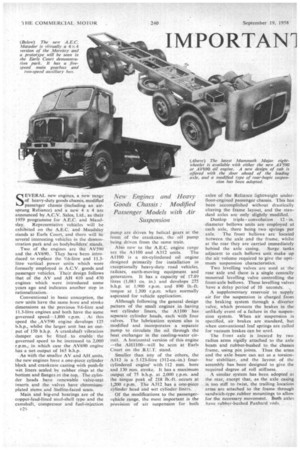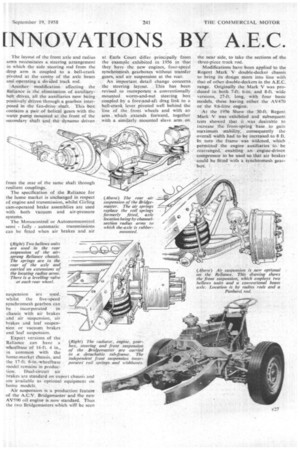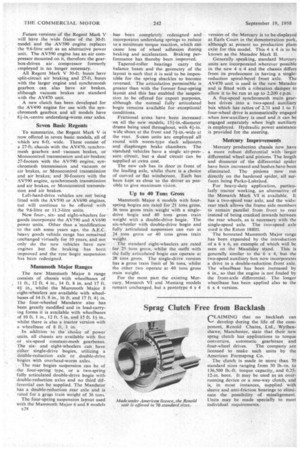IMPORTANI INNOVATIONS BY A.E.C.
Page 116

Page 117

Page 118

If you've noticed an error in this article please click here to report it so we can fix it.
New Engines and Heavy Goods Chassis. Modified Passenger Models with Air Suspension
SEVERAL new engines, a new range of heavy-duty goods chassis, modified passenger chassis (including an airsprung Reliance) and a new 4 x 4 are announced by A.C.V. Sales, Ltd., as their 1959 programme for A.E.C. and Maudslay. Representative vehicles will be exhibited on the A.E.C. and .Maudslay stands at Earls Court, and there will be several interesting vehicles in the derrionstration park and on bodybuilders' stands.
Two of the engines are the AV590 and the AV690. • They have been introduced to replace the 9.6.-litre and 11.3litre vertical power units which were formerly employed in A.C.V. goods and passenger vehicles. Their design follows that of the AV and AH 410 and 470 engines which were introduced some years ago and indicates another step in rationalization.
Conventional in basic conception, the new units have the same bore and stroke dimensions as the previous 9.6-litre and 11.3-litre engines and both have the same governed speed-1,800 r.p.m. At this speed the , AV590 engine develops 125 b.h.p., whilst the larger, unit has an output of 150 b.h.p. A crankshaft vibration damper can be fitted . to enablethe governed speed to be increased to 2,00.0 r,p.rn.,in which case the AV690 engine ha S a net output of 165 b.h.p.
• As with the smaller AV and Alf units, the new engines have a one-piece cylinder block and-crankcase -casting with push-fit wet liners sealed by rubber rings at the bottom and flanges.at the top. The cylinder heads have renewable valve-seat inserts and the valves have chromium.plated stems and Stellite-faced seats.
Main and -big-end bearings are of the copper-read-lined steel-shell type and the camshaft, compressor and fuel-injection r2' pump are driven by helical gears at the front of the crankcase, the oil pump being driven from the same train.
Also new to the A.E.C. engine range are the A1100 and A3I2 units. The A1100 is a six-cylindered oil engine designed primarily for installation in exceptionally heavy-duty road vehicles, railcars, earth-moving equipment and generators. It has a capacity of 17.89 litres (1,083 CU. in.) and develops 275 b.h.p. at 1,900 r.p.m. and 890 lb.-ft. torque at 1,300 r.p.m. when normally aspirated for vehicle application.
Although following the general design pattern of the small engines in having wet cylinder liners, the A1100 has separate cylinder heads, each with four valves. The lubrication system also is modified and incorporates a separate pump to circulate the oil through the heat exchanger in the cooling-water circuit. A horizontal version of this engine —the AH1 100—will be seen at Earls Court on the B.U.T. stand.
Smaller than any of the others, the A312 is a 5.123-litre (312-cu.-in.) fourcylindered engine' with 112 mm. bore and 130 mm. stroke.. It has a maximum output of 75 b.h.p., at_ 2,000 r.p.m. and the torque peak .ot 218 111:-ft. occurs at 1;200 r.p.m. The A3I2 has a one-piece Cylinder head and wet cylinder liners.
. Of the modifications to the passengervehicle range, the most important is the provision of air suspension for both axles of the Reliance lightweight underfloor-engined passenger chassis This has been accomplished without drastically altering the frame layout, and the standard axles are only slightly modified.
Dunlop triple --convolution. 12 diameter bellows units are employed at each axle, there being two springs per axle. The front bellows are located between the axle and the frame, whilst at the rear they are carried immediately behind the axle casing. Surge tanks adjacent to each bellows unit make up the air volume required to give the optimum suspension characteristics.
Two levelling valves are used at the rear axle and there is a single centrally mounted levelling valve controlling the front-axle bellows. These levelling valves have a. delay period of 10 seconds. „
A supplementary reservoir to supply air for the suspension is charged from the braking system through a diverter valve, which protects the brakes in the unlikely event of a failure in the suspension system. When air suspension is specified, air brakes are standard, but when conventional leaf springs are called for vacuum brakes can be used.
The front axle is located by two radius arms rigidly attached to the axle beam and rubber-bushed to the chassis frame, using pin joints. Thus the arms and the axle beam can act as a torsionbar stabilizer, and the layout of the assembly has been designed to give the required degree of roll stiffness.
A similar system has been adopted at the rear, except that, as the axle casing is too stiff to . twist, the trailing location arms are attached to the frame through sandwich-type rubber mountings to allow for the necessary movement. Both axles have rubber-bushed Panhard rods. The layout of the front axle and radius arms necessitates a steering arrangement in which the side steering rod from The drop arm is coupled to a bell-crank pivoted at the centre of the axle beam and.operating a divided track rod.
Another modification affecting the Reliance is the elimination of auxiliarybelt drives, all the auxiliaries now, being positively driven through a gearbox interposed in the fan-drive shaft. This .box contains .a Pair of helical gears with the water pump mounted. at the front of the secondary shaft and the •dynamo driven
from the rear of the same shaft through resilient couplings.
The specification of the Reliance for the home market is unchanged in respect of engine and transmission, whilst Girling cam-operated brake assemblies are used with both vacuum and air-pressure systems.
The Monocontrol or Automonocontrol semi fully automatic transmissions can be fitted when air brakes and air suspension are used, whilst the five-speed synchromesh gearbox can he incorporated in chassis with air brakes and air suspension, air brakes and leaf suspension or vacuum 'brakes and leaf suspension.
Export versions of the Reliance can have a wheelbase of 16-ft. 4 in., in common with the home-market Chassis, and the 17-ft. '6in.-wheelbase model remains in production. Dual-circuit air brakes are standard on export chassis and are available as optional equipment on home models,
Air suspenSion is a production feature .of the A:C.V. Bridgemaster and the new AV590 oil engine is now standard. Thus the two Bridgemasters which will be seen at Earls Court differ, principally from the example exhibited in 1956 in that they have the new engines, four-speed synchromesh gearboxes without transfer gears, and air suspension at the rear.
An important detail change concerns the steering layout. This has been revised to incorporate a conventionally mounted worm-and-nut steering box coupled by a fo.re,-and-aft drag link to a bell-crank lever pivoted well behind the line of the front wheels and with an arm whiph extends forward, together with a similarly mounted slave arm on
the near side, to take the sections of the three-piece track rod.
Modifications have been applied to the Regent Mark V double-decker chassis to bring its design more into line with that of other double-deckers in the A.E.C. range. Originally the Mark V was produced in both 7-ft, 6-in. and 8-ft. wide versions, 27-ft. long, with four basic models, these having either, the AV470 or, the 9.6-litre engine.
At the 1956 Show the 30-ft. Regent Mark V was exhibited and subsequent tests showed that it was desirable to increase the front-spring base to gain maximum stability, consequently the overall width had to be increased to 8 ft. In turn the frame was widened, which pert-flitted the engine auxiliaries to be rearranged, enabling an engine-driven compressor to be used sa that air brakes could be fitted with 'a yri.chromesli gearbox.
Future versions of the Regent Mark V will have the wide frame of the 30-ft. model and the AV590 engine replaces the 9.6-litre unit as an alternative power unit. The AV590 engine has an air compressor mounted on it, therefore the gearbox-driven air . compressor formerly employed is no longer necessary.
All Regent Mark V 30-ft. buses have split-circuit air braking and 27-ft. buses with the larger 'engine and synchromesh gearbox can also have air brakes, although vacuum brakes are standard with the AV470 unit.
A new clutch has been developed for the AV494 engine for use with the synchromesh gearbox and all models have 84-in.-centre underslung-worm rear axles.
Seven Basic Regents
To summarize, the Regent Mark V is now offered in seven basic models, all of which are 8-ft, wide. These consist of a 27-ft. chassis with the AV470, synchromesh gearbox and vacuum brakes, or Monocontrol transmission and air brakes; 27-footers with the AV590 engine, synchromesh transmission and vacuum or air brakes, or Monocontrol transmission and air brakes; and 30-footers with the AV590 engine, synchromesh transmission and air brakes, or Monocontrol transmission and air brakes.
Left-hand-drive vehicles are not being fitted with the AV590 or AV690 engines, but will continue to be offered with the 9.6-litre or 11.3-litre units.
New four-, sixand eight-wheelers forgoods incorporate the AV590 and AV690 power units. Other than a 'modification to the cab some years ago, the A.E.C. heavy goods vehicle range has remained unchanged virtually for 10 years, and not only do the new vehicles have new engines but the braking has been improved and the rear bogie suspension has been redesigned.
Mammoth Major Ranges The new Mammoth Major 6 range consists of chassis with vvheelbases of 11 ft., 12 ft. 4 in., 14 ft. 8 in. and 17 ft. 41 in., whilst the Mammoth Major 8 eight-wheelers are available with wheelbases of 14ft. 8 in., 16 ft. and 17 ft. 41 in. The four-wheeled Mandator also has been greatly modified and in load-carrying forms it is available with wheelbases of 10 ft. 1 in., 12 ft. 5 in. and 15 ft. 11 in., whilst there is also a tractor version with
a wheelbase of 8 ft. 1 in. .
In . addition to the choice of power units, all chassis are available with five or six-speed constant-mesh gearboxes. The sixand eight-wheelers can have either single-drive bogies, utilizing a double-reduction axle or double-drive bogies with overhead-worm axles.
The rear bogies suspension can be of the four-spring type, or a two-spring fdlly articulated double-drive bogie with double-reduction axles and no third differential can be supplied. The Mandator has a double-reduction rear axle and is rated for a gross train weight of 36 tons.
The four-spring suspension layout used with the Mammoth Major 6 and 8 models 28
hasbeen completely redesigned and incorporates underslung springs to reduce to a minimum torque reaction, which can cause loss of wheel adhesion dtiring braking and acceleration, Braking performance has thereby been improved.
Tapered-roller bearings carry the balance beam and the geometry of the layout is such that it is said to be impossible for the spring shackles to become reversed, The articulation permissible is greater than with the former four-spring layout and this has enabled the suspension to be offered for export purposes, although the normal fully articulated bogie remains available for exceptional conditions.
Frictional areas have been increased on all the new models, 154-in.-diameter drums being used throughout, with 41-in. wide shoes at the front and 74-in.-wide at the rear. S-cam units are employed all round with worm-type slack adjusters and diaphragm brake chambers. The standard vehicles have a single air-pressure circuit, but a dual circuit can be supplied at extra cost,
The new cab has its door in front of the leading axle, whilst there is a choice of curved or flat windscreen. Each has been kept as close to the driver as possible to give maximum vision.
Up to 40 Tons Gross Mammoth Major 6 models with fourspring bogies are rated for 21 tons gross, 36 tons gross train weight with a singledrive bogie and 40 tons• gross train weight with a double-drive bogie. The six-wheeler with double-drive bogie and fully -articulated suspension can run at 24 tons gross or 40 tons gross train weight.
The standard eight-wheelers are rated for 25 tons gross, whilst the outfit with the fully articitlated bogie can operate at 28 tons gross. The single-drive version has a gross train limit of 36 tons, whilst the other two operate at 40 tons gross train weight.
For the most part the existing Mercury, Monarch VI and Mustang models remain unchanged, but a prototype 4 x 4
version al the Mercury is to be displayed at Earls Court in the demonstration park, although at present no production plans exist for this model. This 4 x 4 is to be known as the Matador Mark II.
Generally speaking, standard Mercury units are incorporated wherever passible in the new 4 x 4 and the chassis differs from its predecessor in having a single
reduction spiral-bevel front axle. The AV470 unit is used in the new Matador and is fitted with a -vibration damper to allow it to be run at up to 2,200 r.p.m.
A five-speed synchromesh main gearbox drives into a two-speed auxiliary box which has ratios of 2.31 and I to 1: four-wheel drive is automatically engaged when low-auxiliary is used and it can be engaged _separately when high auxiliary is employed. Hydraulic power assistance is provided for the steering.
Mercury Improvements
Mercury production chassis now have a more robust differential with larger differential wheel and pinions. The length and diameter of the differential spider have been increased and bushes have been eliminated, The pinions now run directly on the hardened spider, all surfaces being Parko-Lubrised.
For heavy-duty application, particularly tractor working, an alternative of the Monarch Mark VI is available. It has a two-speed rear axle, and the• widcs.l. rear track allows the frame side members to remain parallel from front to rear instead of being cranked inwards between the rear wheels, as is necessary with the single-speed axle. The two-speed axle used is the Eaton 18800.
"The bonneted Mammoth Major range has been expanded by the introduction of a 6 x 6, an example of which will be seen on the Maudslay stand. This is generally similar to the 6 x 4, but the • two-speed auxiliary box now incorporates a drive to a double-reduction front axle. The wheelbase has been increased by 6 in., so that the engine is not fouled by the front-axle differential. The longer wheelbase has been applied also to the 6 x 4 version.
















































































































































































































